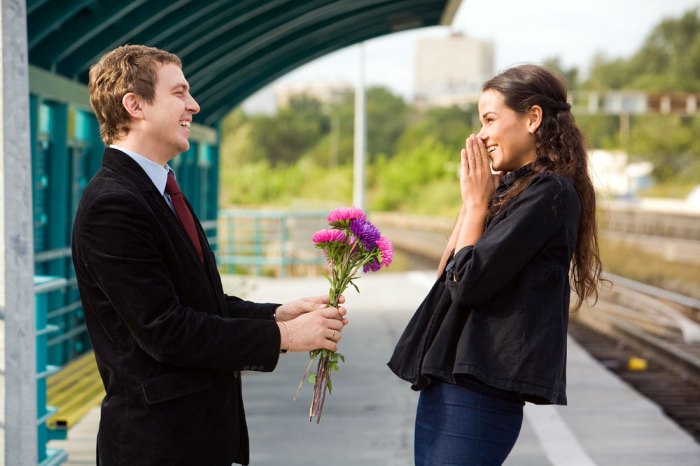Navigating the American dating scene is a complex journey, a blend of digital innovation and enduring traditions. From the swipe-right culture of dating apps to the evolving expectations of modern relationships, the landscape is constantly shifting. This exploration delves into the multifaceted world of American dating, examining the interplay between technology, cultural norms, and individual experiences to paint a comprehensive picture of how Americans find love in the 21st century. We'll uncover the impact of popular dating apps, compare traditional courtship with modern practices, and explore the fascinating regional and cultural variations that shape romantic connections across the nation.
This analysis will unpack the algorithms that curate potential matches, the influence of social media on relationship dynamics, and the evolving expectations around communication, timelines, and financial contributions within relationships. We'll also investigate how factors like ethnicity, religion, and socioeconomic status contribute to the diverse tapestry of American dating experiences, highlighting both the challenges and opportunities inherent in this ever-changing landscape.
Dating App Culture in America

Source: thecoupleconnection.net
Comparative Analysis of Popular Dating Apps
The American dating app market is dominated by several key players, each catering to a specific demographic and offering unique features. Understanding these differences is crucial to grasping the nuances of the dating app landscape. The following table provides a comparative analysis of some of the most prominent apps:| App Name | Target Demographic | Key Features | User Base Size (Estimate) |
|---|---|---|---|
| Tinder | Broad, ranging from young adults to older singles; known for its casual approach. | Swipe-based matching, photo-centric profiles, location-based discovery, "Super Likes," and "Boost" features. | 75 million+ monthly active users |
| Bumble | Women-centric; known for empowering women to initiate contact. | Similar to Tinder in its swipe-based functionality but with women initiating contact. Offers BFF and business networking features. | 40 million+ monthly active users |
| Hinge | Relationship-oriented; emphasizes meaningful connections over casual encounters. | Detailed profile prompts encouraging thoughtful responses, focus on shared interests and values, limited swiping. | 10 million+ monthly active users |
| OkCupid | Diverse demographic; known for its in-depth questionnaires and matching algorithms. | Extensive personality questionnaires, detailed profile options, matching based on compatibility, various communication options. | 5 million+ monthly active users |
Impact of Social Media Integration
Social media integration has significantly altered the American dating app experience. Many apps allow users to connect their social media profiles, providing additional context and information about potential matches. This integration can streamline the profile creation process, but it also raises privacy concerns. For example, a user's Facebook friends might appear on a dating app, potentially leading to awkward encounters or unintended disclosures. The ease of sharing photos and other personal details through integrated platforms can also accelerate the formation (or destruction) of initial impressions, potentially influencing relationship development speed and stability. Furthermore, the constant visibility on social media can create pressure to present an idealized version of oneself, affecting authenticity in online interactions.Role of Algorithms and Matching Systems
Dating app algorithms play a crucial role in shaping user experiences and potential relationships. These algorithms analyze user profiles, preferences, and behaviors to suggest potential matches. While the specific algorithms used by each app are proprietary and often kept secret, they generally consider factors such as age, location, interests, and common connections. The algorithms' influence on user experience is significant, as they curate the pool of potential matches presented to each individual. This curated presentation can both broaden opportunities and limit exposure to individuals outside of the algorithm's parameters. The constant refinement and adjustment of these algorithms based on user interaction and data analysis significantly impact the long-term success and user satisfaction of the platform. For example, a highly successful match might lead the algorithm to present more similar profiles in future suggestions. Conversely, a series of unsuccessful interactions might trigger adjustments in the matching criteria.Traditional vs. Modern Dating Practices
American dating culture has undergone a dramatic transformation, moving from traditional courtship rituals to the fast-paced, technology-driven landscape of modern dating. This shift reflects broader societal changes in gender roles, communication styles, and relationship expectations. Understanding these differences is crucial for navigating the complexities of contemporary relationships.The evolution from traditional courtship to modern dating is characterized by a significant shift in power dynamics, communication methods, and the overall pace of relationship development. Technology has fundamentally altered the way people meet, interact, and form relationships, leading to both advantages and challenges.Key Differences Between Traditional and Modern Dating
The contrasting approaches to dating highlight a significant divergence in societal expectations and relationship dynamics. Traditional courtship often involved a structured progression, with clear roles and expectations, while modern dating is characterized by more fluidity and ambiguity.- Initiation: Traditionally, men were expected to initiate contact and pursue women. Modern dating allows for greater gender equality in initiating contact, with both men and women equally likely to make the first move.
- Role of Family and Community: Traditional courtship often involved significant family and community involvement, with parents playing a crucial role in matchmaking and relationship approval. Modern dating is largely independent of family oversight, with individuals having greater autonomy in choosing partners.
- Pace of Relationship Development: Traditional courtship was a slower, more deliberate process, with a clear progression from initial acquaintance to marriage. Modern dating is often faster-paced, with individuals potentially moving quickly from initial contact to physical intimacy and commitment.
- Communication Methods: Traditional courtship relied primarily on face-to-face interactions, letters, and phone calls. Modern dating heavily utilizes technology, including dating apps, social media, and text messaging, creating new forms of communication and interaction.
- Dating Goals: Traditional courtship often had marriage as the primary goal. Modern dating encompasses a wider range of goals, from casual dating and hookups to serious relationships and marriage.
Evolving Expectations in Dating
Expectations surrounding communication, relationship timelines, and financial contributions have significantly evolved. Open communication is now highly valued, alongside a greater understanding and acceptance of diverse relationship structures.The traditional expectation of men being the primary financial providers is increasingly challenged. Modern dating often involves more egalitarian approaches to financial contributions, with shared expenses being common. Relationship timelines are also more fluid, with less emphasis on traditional milestones like marriage or cohabitation. Communication styles have shifted towards more direct and open expression of needs and desires. For example, the use of dating apps often leads to more upfront discussions about relationship goals early in the dating process.Navigating Traditional and Modern Approaches Simultaneously
Imagine Sarah, a 28-year-old woman raised with traditional values who feels pressure from her family to find a husband. Simultaneously, she uses dating apps, navigating the fast-paced, less structured world of modern dating. She struggles to balance her family's expectations with her desire for autonomy in choosing a partner. She finds herself torn between the slow, deliberate approach favored by her family and the quick-paced interactions common in app-based dating. This creates internal conflict, as she attempts to reconcile her upbringing with the realities of modern dating culture. She might feel frustrated by the casual nature of some app encounters, while also feeling judged by her family for not adhering to their traditional expectations. This scenario highlights the challenges individuals face when attempting to navigate both traditional and modern dating approaches simultaneously. The resulting tension can lead to stress, confusion, and potentially, relationship difficulties.Regional and Cultural Variations in American Dating

Source: squarespace-cdn.com
Regional Dating Culture Variations
The United States exhibits diverse dating customs and social norms across its regions. Three distinct examples illustrate this variety: the Northeast, the South, and the West Coast. The following table summarizes key differences:| Region | Dating Customs | Social Norms | Common Relationship Dynamics |
|---|---|---|---|
| Northeast (e.g., New York City, Boston) | Fast-paced, often involving multiple dates concurrently; direct communication preferred; emphasis on career and independence. | Independent and ambitious individuals are valued; public displays of affection can vary widely; a more cosmopolitan and diverse dating pool. | Relationships may develop quickly or slowly depending on individual preferences; strong emphasis on shared goals and intellectual compatibility. |
| South (e.g., Texas, Georgia) | Traditional dating practices more prevalent; importance placed on family and social circles; courtship may be slower and more deliberate. | Strong family ties influence dating; religious beliefs often play a significant role; hospitality and politeness are highly valued. | Relationships often develop within established social networks; commitment and long-term stability are prioritized; family approval is often crucial. |
| West Coast (e.g., California, Oregon) | Casual dating is common; emphasis on shared interests and outdoor activities; relaxed and open-minded approach. | Emphasis on personal growth and self-expression; acceptance of diverse lifestyles and relationships; a more laid-back attitude towards dating. | Relationships may be less formal and more fluid; emphasis on individual autonomy and shared experiences; commitment may develop gradually. |